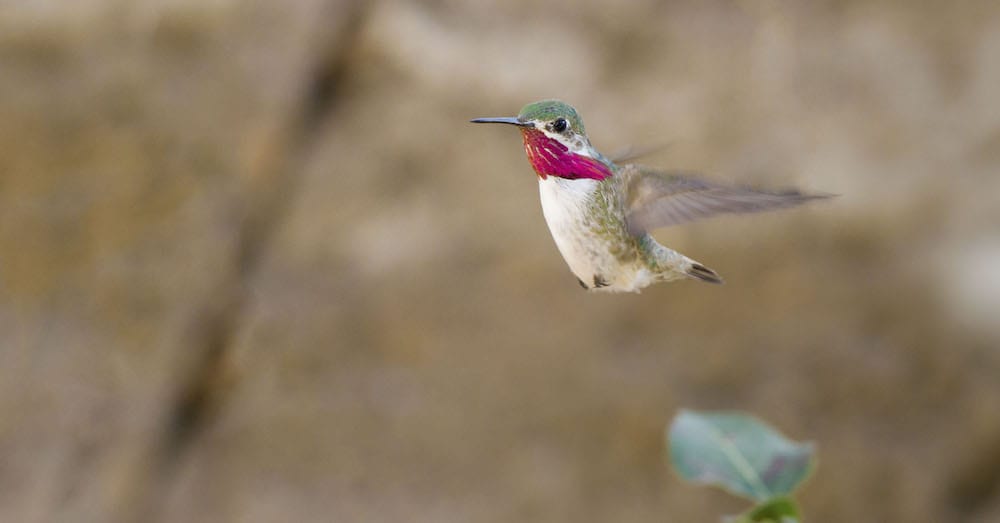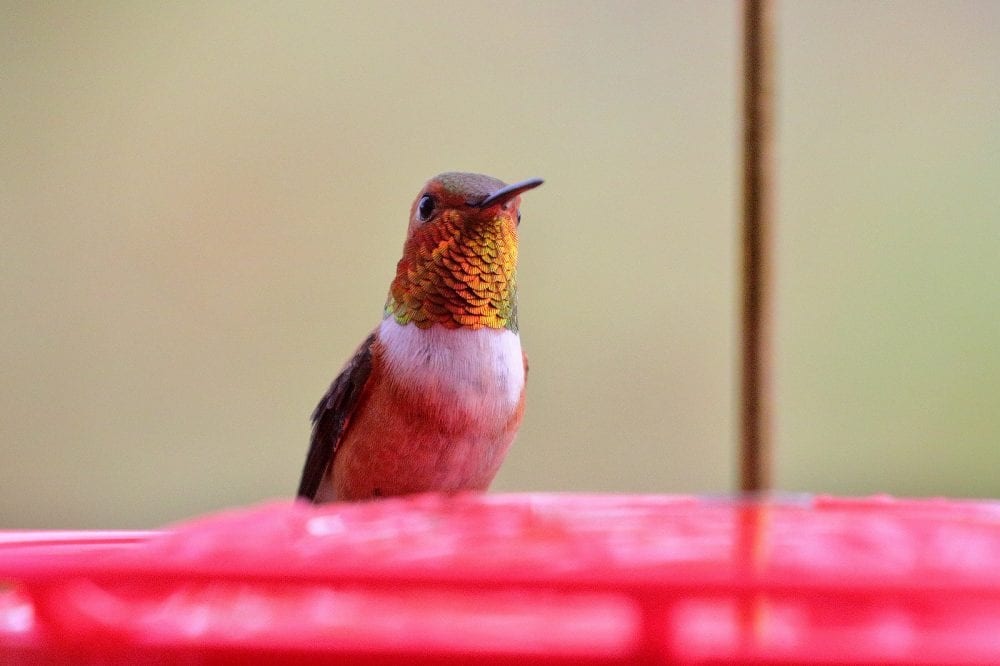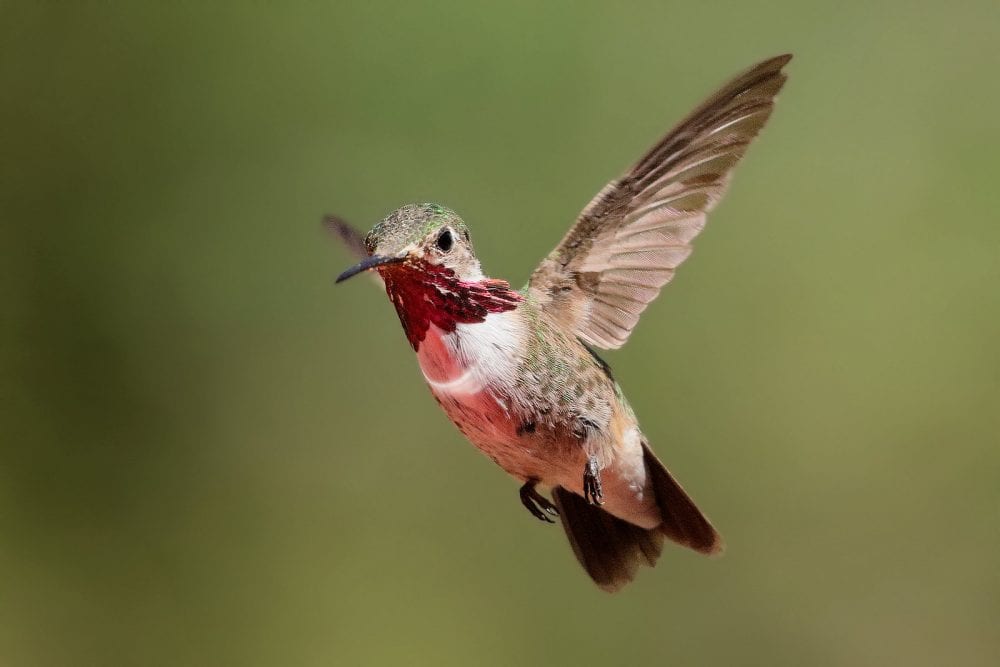
Want to learn more about our local hummingbirds? Join Bob Loy and Lisa Roig on Tuesday, June 15, 2021, for a talk about the Hummingbirds of Bandelier National Monument. Learn more and register here.
By Bob Loy
I am fascinated by bird behavior. Almost every bird species has some characteristic that separates it from others. Hummingbirds are one of the most unique types of bird found here on the Pajarito Plateau. We are very fortunate to have four species of hummingbirds visit us each year. That may not seem like a lot, but those who live east of the Mississippi only see one regular hummingbird visitor each year. We are lucky to live in such a special place.
While only eight species of hummingbird breed in the United States, you may be surprised to learn that hummingbirds are one of the largest families of birds (second only to flycatchers) with an estimated 338 recorded species found worldwide. Hummingbirds are unique to the Western Hemisphere. Ecuador claims the most species with a whopping 163!
Here are a few fun facts about hummingbirds in general before we discuss the hummingbirds of Northern New Mexico:
- Male hummingbirds are deadbeat dads, making the females the ultimate single mothers. Males and females only come together to mate for a fraction of a second. After that, the female does everything on her own, including building the nest; laying, sitting on, and guarding the eggs; and protecting and feeding the young until they fledge. Wow! That’s a lot of work.
- They have tiny little feet that are only good for perching, scratching, or preening. If they wish to move — even a few inches — they must fly.
- If they don’t eat, hummers can starve to death in about an hour.
- They eat every 10 minutes throughout the day.
- Hummingbirds have very good memories and are even able to remember where they found food from the previous year.
- These birds fly at 25 – 30 miles per hour regularly. They can reach speeds of 60 miles per hour when performing a diving display during mating.
- Hummingbirds are the only bird that has an insect as a predator. Praying mantises will go after them on occasion!
- The average lifespan for hummingbirds is 3 – 6 years. The record is 12 years held by a female Broad-tailed Hummingbird. We know this thanks to bird banding!
- Female hummingbirds usually lay two eggs that are about ½ inch long.
- The eggs hatch in 13 – 22 days depending on the species.
- Hummingbirds are very important pollinators of flowers, shrubs, and trees.
The four species that visit us here in Northern New Mexico are the Broad-tailed Hummingbird, Black-chinned Hummingbird, Rufous Hummingbird, and Calliope Hummingbird. Broad-tailed and Black-chinned Hummingbirds both arrive in the spring and breed here. Rufous and Calliope Hummingbirds arrive later in the summer, usually in July or August.
Get to know each of the species that we find in Northern New Mexico!

Broad-tailed Hummingbirds
- The wings of males make a distinct trilling sound when flying. You will often hear them before seeing them and this makes them easy to identify!
- Broad-tailed Hummingbirds are the highest altitude breeder of any hummingbird found in the U.S. They will breed at elevations of up to 10,500 feet.
- They are especially attracted to red tubular flowers.

Black-chinned Hummingbirds
- Black-chinned Hummingbirds are widespread and are found in a variety of habitats — from deserts to high mountain forests. They are adaptable and can be found in urban areas and recently disturbed habitats.
- Their eggs are about the size of a coffee bean. The nests, which are usually made from plant material and spider webs, expand as their babies grow.

Rufous Hummingbirds
- Rufous Hummingbirds are extremely territorial! Once they’ve found a good nectar source, they will chase away any hummingbird that tries to drink from their flowers or feeders.
- Rufous Hummingbirds breed as far north as southeast Alaska, making them the northernmost breeder of any hummingbird in the world.
- These hummingbirds have a very long migratory route and travel clockwise across western North America annually. They go up the Pacific Coast in late winter and spring and reach the Pacific Northwest by May. They head south in early July, traveling along the Rocky Mountains.

Calliope Hummingbirds
- The Calliope Hummingbird is the smallest bird in continental North America.
- These birds are small, but mighty! They are quite territorial and have been seen chasing away birds as big as Red-tailed Hawks during breeding season.
- It weighs about as much as a penny at roughly 2.5 grams!
Keep an eye and ear out for our hummingbirds in the coming weeks! Broad-tailed and Black-chinned Hummingbirds should begin to arrive in early April.
If you decide to feed hummingbirds, there’s no need to buy the fancy store nectar. It’s easy to make your own! A simple solution of one-part sugar to four-parts water is all it takes with no boiling or dyes required. Check out this hummingbird food recipe and some feeding guidelines from All About Birds. Be mindful that this juice spoils quickly in the hot weather, so be sure to change it regularly! Change your water before it gets cloudy or discolored. Sugar water ferments quickly in the summer and produces a toxic alcohol. We recommend changing your water daily or, at the most, every two days during the warmest days of the year.

Thanks for the beautiful pictures and the information is very helpful. So an insect is the predator interesting.
I thought the males guarded the nests with their bright plumage and females taking care of raising their offspring.
Love them hummingbirds. Informative and interesting. No need for store bought nectar. So, put out those feeders.
Spotted a rufous hummingbird at my feeder today! I’ve never seen a hummingbird that color before. Thanks for helping me ID the thing.